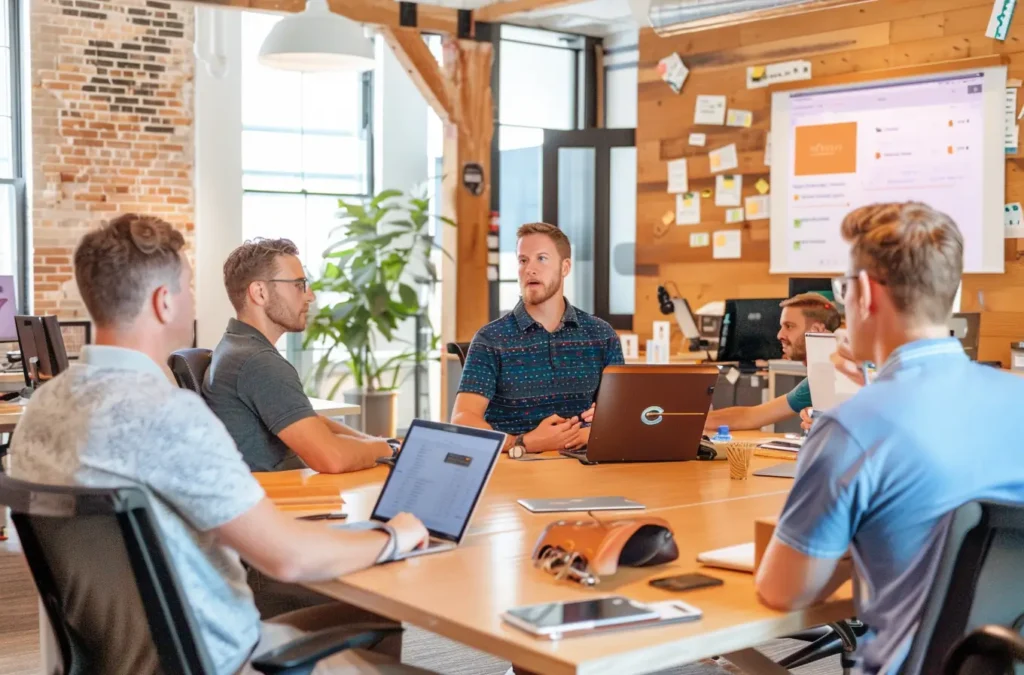Table of Contents
Introduction
So, you’ve heard of SEO, right? It’s the advanced digital marketing plan for promoting your website on the internet. Perhaps you are simply thinking about learning SEO. But as soon as you begin to dig into it, you’re bombarded with a slew of perplexing jargon and acronyms, making you think: keywords, backlinks, and SERPs—what on earth do they all mean? Well, take it easy!
We know that understanding the nuances of SEO terms might feel like learning a new language, so we’re glad to help. This introductory tutorial provides an in-depth review of key concepts in the SEO landscape. From keywords to backlinks, we’ll break down each term into digestible bits, helping you to steer the digital arena. Let’s dive into the sea of learning!
Pro Tip: Save or bookmark this ultimate cheat sheet to ensure you take advantage of every beat vital for your successful SEO journey. Trust us, you can't afford to lose it!
SEO Terms For Beginners: 40+ SEO Terms!
Basic SEO Concepts
1. SEO
Search Engine Optimization (SEO) makes your website more visible on search engines like Google, Yahoo and Bing. It helps more people find your site when searching for things related to your offer. It involves different strategies to foster your website’s rating in search results, making it easier for potential customers to discover you online.

2. Local SEO
Local SEO focuses on attracting customers in your local area. It’s important for businesses with physical locations or those serving specific geographic areas. Local SEO include:
- Google My Business Profile (GMB): a free online business profile where you can showcase your information, such as your address, hours, and what you offer. This makes it easier for customers to find you on Google Search and Maps.
- Local Citations: are online mentions of your business name, address, and phone number on different websites and directories, helping people discover your business more easily.
- NAP (Name, Address, Phone Number) Consistency: It’s about ensuring that your business’s name, address, and phone number are the same everywhere online, which boosts your credibility and makes it simpler for customers to reach you.
- Local Keyword Research: different from organic SEO keyword research. It involves finding out the specific words and phrases used by people in your area when searching online. This information helps you tailor your website content to match their searches and attract more local customers.
In short, all these techniques help local customers find and visit your business easily.
3. On-Page SEO
On-page SEO is adjusting individual pages of your website to increase its internet search engine ranking. This includes things like:
- using pertinent keywords in your content,
- optimizing meta tags and
- ensuring your website is easy to navigate.
By making these optimizations, you can help search engines understand what your pages are about and rank them higher in search results.
4. Off-Page SEO
Off-page SEO seeks on building your website’s authority and legitimacy through external factors. It signals to search engines that your website is trustworthy and valuable, which boosts your rankings. This entails:
- creating backlinks to your website.
- communicate with your audience through social media.
- monitor your World Wide Web reputation.
5. Technical SEO
This is the process of tweaking your website’s technical components to increase its search engine visibility. It helps search engines crawl and index your website more effectively, leading to more profitable rankings in search results. Technical SEO aims at:
- improving site speed
- ensuring mobile-friendliness, and
- implementing structured data markup.
6. Enterprise SEO
Enterprise SEO is for large-scale websites with complex structures and many content and pages. This approach typically caters to big websites with lots of pages. It involves strategies like:
- scaling content creation,
- optimizing technical aspects across thousands of pages and
- automating certain tasks.
7. Keywords and Keyword Research
Keywords are the words and phrases people use and type in the Google search bar for information online, such as “best smartphone in 2024,” “how to lose weight,” and many others. Whereas, Keyword Research means identifying which keywords are relevant to your business and have high search volumes. By targeting the right keywords, you can increase site traffic and efficiently increase your potential customer base.
Now, when it comes to keywords, there are different types:
- Branded Keywords: include your brand name or specific product names, such as “Nike Air Max” or “Toyota Cars.” These keywords help people find your website when searching for your brand specifically.
- Long-tail keywords: are specific and detailed search phrases with lower search volumes. For example, “Dell XPS 13 laptop with 4K display.” They target niche audiences with specific search intent. While they may attract less traffic individually, long-tail keywords can collectively drive highly relevant traffic to your website and improve your chances of conversion.
- Short Tail Keywords: are broad and general search terms with high search volumes, such as “Vacation rentals.” They target a wide audience but are also highly competitive. These keywords are often used at the awareness stage of the buyer’s journey when people are just starting their search for information.
8. Backlinks
Backlinks are links from other websites that point to your website. They are an important off-page SEO factor that indicates your website’s authority and credibility.
9. Black Hat SEO
Black Hat SEO refers to unethical techniques used to manipulate search engine rankings. These practices break search engine benchmarks, resulting in penalties or removing your website from search results. Examples include:
- Keyword stuffing: using too many unrelated words repeatedly to try to trick search engines into ranking a webpage higher.
- Buying links: paying for links from other websites to boost a site’s search engine ranking, which is against search engine rules.
- Duplicate content: having the same or nearly identical content on different web pages, which can confuse search engines and result in lower rankings for those pages.
10. Internal Links
Internal links are links from one page on your website to another. They help users navigate your website and distribute link equity throughout your site. They further help search engines discover and index your website’s content more effectively.
11. White Hat SEO
White Hat SEO directs to ethical and legitimate SEO techniques that comply with search engine policies. These practices focus on providing valuable content, improving user experience, and naturally earning backlinks. The good part of White Hat SEO is it aims to sustainably improve your website’s rankings without risking penalties from search engines.
12. Meta Description
A meta description summarizes a webpage’s content and appears right under the title in search engine results. It provides users with information about what they can expect to find on the page. It is about 120-155 words long and can influence users’ decisions to click on your website.
13. Title Tag
A title tag is an HTML element that defines a webpage’s title. It appears in search engine results and browser tabs, providing users with a preview of the page’s content. Title tags are highly important for SEO since they impact your website’s click-through rates and search engine rankings.
14. SERP (Search Engine Results Page)
A Search Engine Results Page (SERP) is the page displayed by search engines in response to a user’s search query. It includes organic search results, paid advertisements, and SERP features like featured snippets and knowledge panels. It delivers users relevant information and options to explore further based on their search intent.
15. Crawling
Crawling is the methodology by which search engine bots routinely examine the internet in order to find and index site pages. It enables search engines to update their indexes and deliver relevant search results to users. It involves following links from one webpage to another and analyzing website content.
16. Indexing
Indexing is adding webpages to a search engine’s database after crawling them. It involves analyzing and storing webpage content to make it searchable for users. The process lets search engines retrieve and display relevant web pages in response to user queries.
17. Organic Traffic
Organic traffic refers to visitors who arrive at your website through unpaid search engine results. It’s driven by users’ natural interest or relevance to your website’s content and offerings.
18. Page Rank
Page rank is a metric search engine used to evaluate the importance and relevance of web pages in their index. It measures the quality and quantity of inbound links to a webpage, influencing its position in search engine results.
19. Bounce Rate
Bounce rate is another metric that measures the percentage of visitors who leave your website without interacting with other pages. It indicates the effectiveness of your website in engaging visitors and encouraging further exploration. Additionally, a high bounce rate may suggest issues with website design, content relevance, or user experience that must be addressed.
20. Google Algorithms
Google algorithms such as Panda, Penguin, and Hummingbird are the complex sets of rules and formulas that Google uses to determine the relevance, quality, and ranking of web pages in its search engine results pages (SERPs). This determination is based on factors such as keywords, website quality, content freshness, user experience, and many others to determine which pages should rank higher for specific search queries. However, it is important to note that these algorithms are constantly updated and refined, so being aware of them at all times is important to let your site stand out on first SERPs.
Technical SEO Terms
21. Page Speed Optimization
This refers to the process of making web pages load faster. To optimize page speed, reduce file sizes and minimize the number of files your page needs to load. Faster loading times lead to better user experiences and higher rankings on Google.
22. Mobile-First Indexing
Google now primarily uses the mobile version of websites for indexing and ranking. This means your site must be optimized for mobile devices and function seamlessly on smartphones and tablets to reach a broader audience, maintaining visibility in search results.
23. User Experience (UX)
User experience refers to a visitor’s overall experience when interacting with your website. It includes page speed, navigation ease, mobile responsiveness, engaging content, and brand connection. A positive UX leads to higher rankings on search engines and increased user satisfaction.
24. HTTPS and SSL
HTTPS (Hypertext Transfer Protocol Secure) and SSL (Secure Sockets Layer) encrypt data transmitted between a user’s browser and your website. HTTPS encrypts data between websites and visitors, enhancing security and trust. SSL certificates are essential, especially for e-commerce sites handling sensitive information. Implementing HTTPS and SSL boosts your site’s credibility and protects user data from potential security threats.
25. URL
A URL is the web address of a specific webpage. It serves as a unique identifier for accessing content on the internet. URLs help users and search engines navigate your website’s structure and locate desired information efficiently.
26. Redirects (301, 302)
Redirects automatically send users from one URL to another. A 301 redirect indicates a permanent move, while a 302 redirect signifies a temporary change. Properly implementing redirects helps maintain website usability and preserves search engine rankings during site changes or updates.
27. 404 Pages
A 404 page is a custom error page displayed when a requested page doesn’t exist on a website. They help retain visitors by providing helpful information or guiding them to relevant content. Customizing 404 pages with helpful content and navigation links improves user experience and reduces bounce rates.
28. Sitemaps
Sitemaps are lists of URLs that help search engines discover and index your website’s content. Submitting a sitemap to search engines ensures all pages are crawled and indexed efficiently, improving your site’s visibility and search engine rankings.
29. XML Sitemap
An XML sitemap is a specific sitemap format designed to help search engines crawl and index your website’s pages more effectively. XML sitemaps provide detailed information about your site’s structure and priority content, facilitating better search engine optimization.
30. Schema Markup
Schema markup, also known as structured data, helps search engines better understand your website’s content. By implementing schema markup, you can enhance your site’s visibility in search results and enable rich snippets, improving user engagement and click-through rates.
31. Canonical Tag/URL
The canonical URL is the main URL of a page when multiple versions exist. Canonical tags designate the preferred version of a page, ensuring search engines index and display the correct URL in search results.
32. Robots.txt
Robots.txt is a text file that instructs web crawlers on which pages to crawl and index on your website. By specifying which pages to exclude from crawling, you can control how search engines access and display your site’s content in search results.
33. Image ALT Text
Image ALT tags are descriptive text for images that help search engines understand their content and data. By providing context for images, you can improve accessibility for all, including visually impaired users, and enhance your site’s SEO.
Content Related Phrases
34. Content Management System/CMS
A Content Management System (CMS) is like a clubhouse for digital content. It’s a tool that lets you manage and share stuff online, like articles, pictures, and web pages, without needing to be a computer expert. You can use it to create and organize your content easily, whether you’re a blogger, a business owner, or just someone who wants to share things online.
35. Content Optimization
Content optimization means boosting your content to help more people find it online. It involves using the right words and tags to make sure your words shine high and show up in search results. This helps attract search engines, which results in more visitors and conversions.
36. Content Calendar
A content calendar is like your plan for posting stuff online. It helps you schedule when and where to share articles, blog post, videos, or social media posts. Using a content calendar, you can stay organized and ensure you’re reaching your audience regularly on different platforms, like your website, Facebook, or YouTube.
37. Content Quality
Content quality means writing content that’s really good and helpful for people. It’s about creating articles, videos, or pictures that people enjoy and find useful. Instead of getting many views, quality content focuses on giving people what they want: information, entertainment, or inspiration.
38. Image Optimization
Image optimization means making sure your pictures look great online. It means resizing and compressing images so they load quickly and adding descriptions (Image ALT Text, which we discussed in the technical portion) to make them accessible to everyone. By optimizing your images, you can make your website look better and improve the experience for your visitors.
Some More General Terms
39. Google Analytics
Google Analytics is a fundamental tool in the world of SEO. Imagine it as your website’s personal detective, collecting valuable data and providing insights into how users interact with your site. With Google Analytics, you can track important metrics like website traffic, user behavior, and conversion rates. This information helps you understand what’s working well on your site and what areas need improvement.
40. Google Search Console
Google Search Console is another essential tool. Think of it as your direct line of communication with Google. This free tool provides valuable insights into how your website is performing in Google search results. It helps you monitor your site’s visibility, identify any issues impacting its ranking, and optimize its appearance in search listings.
With Google Search Console, you can track important metrics like clicks, impressions, and click-through rates and identify opportunities to improve your site’s SEO performance. It also allows you to submit sitemaps, check for manual penalties, and ensure that all your website’s pages are properly indexed by Google.

41. Conversion Tracking
Conversion tracking focuses on measuring users’ actions on your website. These actions, or conversions, can include purchasing, signing up for a newsletter, or filling out a contact form. By tracking conversions, you can assess your SEO efforts’ effectiveness and identify areas for improvement.
For example, you can determine which pages or keywords are driving the most conversions and identify any bottlenecks in your conversion funnel. This insight allows you to optimize your website and marketing strategies to drive more conversions and ultimately achieve your business goals.
42. Guest Posting
Guest posting is a strategy for building backlinks to your website, which is essential for improving your site’s authority and visibility in search engine results. The idea is simple: you write an article or contribute content to another website in your niche, and in return, you’re allowed to include a link back to your own site. However, it’s important to approach guest posting strategically and ethically. Here are a few suggestions.
- focus on writing high-quality content that provides value to the audience of the website you’re contributing to
- ensure that the site is relevant to your own and
- avoid large-scale guest posting campaigns with keyword-rich anchor text links, as these can violate Google’s quality guidelines and harm your site’s SEO efforts.
43. SEO Plugins
SEO plugins are extension modules offering a range of tools and features to help you optimize your site for search engines. These plugins, such as All in One SEO, Yoast, and RankMath, can be added to your content management system (CMS), such as Squarespace or WordPress, to streamline your SEO efforts. They typically offer features like keyword suggestions, meta-tag optimization, content analysis, and more. SEO plugins ensure that your website is properly optimized for search engines, making it easier for users to find your content online.
44. Keyword Research Tools
Keyword research tools are treasure maps for your website. They help you discover the words and phrases people type into search engines when looking for something online. Using these tools, you can find out which keywords are popular in your niche and which are easier to rank for. This information helps you create content that matches users’ intent, making your website more likely to appear in search results.
Popular keyword research tools include Google Keyword Planner, which is free to use and provided by Google itself, and UberSuggest, which gives you insights into keyword ideas, search volume, and competition levels. Other top options include Semrush, Moz Pro, and Ahrefs to get your website seen by more individuals online.
BONUS PACK: Emerging SEO Terminologies in 2024
As digital marketing and SEO experts at HNK, we know the year 2024 is an incredibly exciting time for SEO. Hence, we want to make sure you and your clients are fully clued in on all the upcoming terms that could make or break your success. So, here’s some more knowledge coming your way.
45. Video SEO
Have you ever noticed how some videos pop up right at the top when you search for something on YouTube or TikTok? That’s no coincidence – it’s all about Video SEO. Video SEO means optimizing video content to improve its visibility and ranking on search engine results pages (SERPs). This involves various strategies, such as using relevant keywords in titles, descriptions, and tags and transcribing videos for better accessibility.

46. E-E-A-T
You know how when you’re looking for information online, you tend to trust certain websites more than others? That’s where E-E-A-T comes in. E-E-A-T stands for Experience, Expertise, Authoritativeness, and Trustworthiness, which are important factors that search engines like Google consider when ranking content. This means if you can prove you know your stuff, have good credentials, and people trust your site, Google will rank you higher. Its key aspects are:
- demonstrating expertise in your field
- establishing authority through credentials and backlinks from reputable sources, and
- fostering trust among your audience.
47. AI (Artificial Intelligence) in SEO
So, you know that Google keeps changing its search algorithms. Well, artificial intelligence (AI) is the secret sauce behind those changes. These technologies help Google understand what users want and deliver better search results. For businesses in 2024, it’s important to use AI-powered tools such as ChatGPT, Jasper or GitHub to stay ahead. They can help find the right keywords, optimize content, and ensure your website is user-friendly.
48. Voice Search Optimization
Imagine you’re cooking dinner and want to know how long it takes to bake a cake. Instead of typing it out, you ask for help from your voice assistant, like Siri or Google Assistant. That’s a voice search. And businesses need to make sure their content is optimized for it. By using natural language and answering common questions, you can improve your chances of showing up in voice search results. With so many people using voice assistants, it’s a big deal for SEO in 2024.
49. Featured Snippets
Featured snippets are concise answers to users’ queries at the top of search results. These position-zero results provide quick information to users and significantly increase visibility and credibility for businesses. Optimizing content to appear in featured snippets involves tailoring content to match snippet types like paragraphs, lists, or tables and monitoring performance for specific keywords.
50. Hyperlocal Targeting
Hyperlocal targeting involves delivering highly targeted ads based on precise geographic locations, such as specific neighborhoods or streets. This strategy allows businesses to refine their audience reach, especially in competitive local markets. It enables businesses to deliver personalized content and offers it to potential customers at the right time and place, ultimately driving engagement and conversions.

51. SEO Experts
And finally, while working and learning, you will come across the term “SEO Experts/Agency.” Who are they? Why you must hire them? Well, it must be clear with words itself that SEO experts are the individuals, professionals, and specialists whom you can trust with heart and mind to take care of your business SEO.
They are the wizards of the internet. You turn to them when you want your website to appear at the top when people search for something related to your business.
They’re not just good with fancy terms and tools but also know how to use them in the best way possible to make your website shine bright on search engines. They keep an eye on what people are searching for and use clever tricks to ensure your website gets noticed, your business grows, and gets many visitors who could turn into customers.
Suggested reading:
Need an SEO Expert? Partner up with Hyder and Kabani (HNK)!
If you’re groping a bit lost in the world of SEO, don’t worry, we’ve got your back. SEO is always changing, and keeping up with the latest trends and techniques can be tough. But that’s where we come in.
At Hyder and Kabani, we live and breathe SEO. Whether you’re confused by the jargon or need help growing your small business online, we’ve got the expertise to guide you through it all.
For the past five years, we’ve been helping clients like you find success online. From designing killer websites to optimizing them for search engines (from local to technical SEO and keyword research to SEO audit), we’ve covered all your bases. Learn more about us here, or contact us to get your free quote today.
Learn → Questions to Ask SEO Agency.
FAQs
Why is SEO important?
SEO is important because it helps your website show up higher in search engine results when people search for things related to your website. This means more people can find your site, leading to more visitors and potential customers.
How long does it take to see results from SEO?
Seeing results from SEO can take time. It depends on many factors, like how competitive your keywords are and how much work you put into optimizing your site. It could take weeks or months to see significant changes, so patience is key.
What are the most common SEO mistakes to avoid?
Some common SEO mistakes include stuffing your website with too many keywords, not creating high-quality content, and ignoring technical issues like broken links. To avoid these mistakes, it’s important to focus on providing value to your visitors and following best practices.
How can I measure the success of my SEO efforts?
To measure your SEO success, begin by tracking how many people visit your website from search engines, which keywords they use to find you, and how long they stay on your site. Tools like Google Analytics can help you track these metrics and see how your SEO efforts are paying off.
What Local SEO is important?
Local SEO is highly important for businesses that serve a specific geographic area because it helps them reach people who are nearby and ready to buy. Local SEO tactics include claiming your Google My Business listing and getting reviews from local customers.

